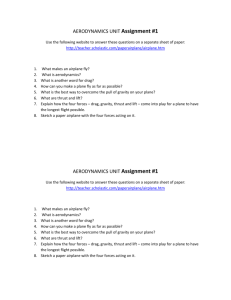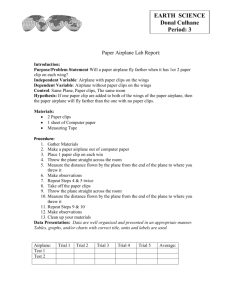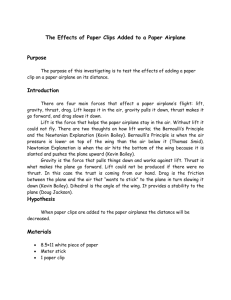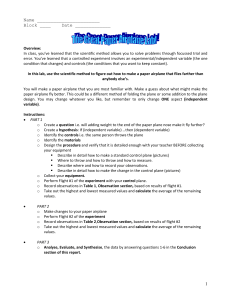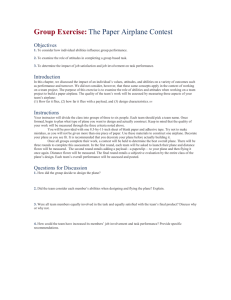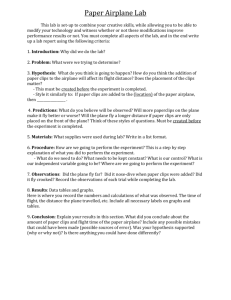FLYING PAPER AIRPLANES By: Bill Smith A SCIENCE FAIR
advertisement
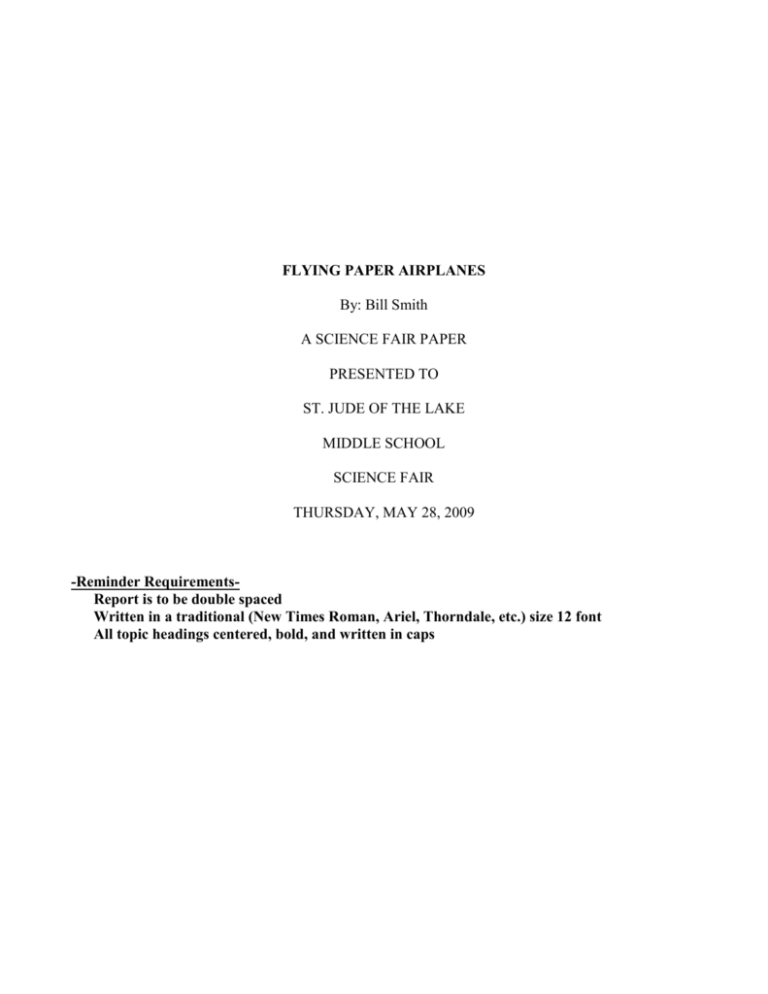
FLYING PAPER AIRPLANES By: Bill Smith A SCIENCE FAIR PAPER PRESENTED TO ST. JUDE OF THE LAKE MIDDLE SCHOOL SCIENCE FAIR THURSDAY, MAY 28, 2009 -Reminder RequirementsReport is to be double spaced Written in a traditional (New Times Roman, Ariel, Thorndale, etc.) size 12 font All topic headings centered, bold, and written in caps ABSTRACT The problem is, “Will the number of paper clips on the nose of a paper airplane affect the distance that it can fly?” It is hypothesized that five paper clips on the nose of a paper airplane will make the plane fly farther than with none, one, or three paper clips on the plane's nose. A brief procedure of the experiment is as follows. One plane was made according to the directions given in the Procedure of Investigation. This same plane was flight tested in the same breezeless hallway, using the same amount of thrust, and the same angle of release to fly the plane. The flight distances for each test were measured in meters. All tests were repeated for a total of three trials. That is, three tests for each of the following: no paper clips, one paper clip, three paper clips, and five paper clips. Data were taken and recorded. The results support the hypothesis. STATEMENT OF THE PROBLEM Will the number of paper clips on the nose of a paper airplane affect the distance that it can fly? REVIEW OF LITERATURE Airplanes are much heavier than air. So what keeps them up in the air? There are four forces which act on a plane in flight. These forces are thrust, lift, drag, and gravity. Thrust and lift are the forces which allows the airplane to fly. Thrust is caused by the engine's force which pushes the plane forward into the air. Air moving over the plane's wings causes lift. The distance over the top of the wing of a plane is greater than the distance on the bottom of the wing. The air that flows over the top of the wing has farther to go than the air under the wing. The top air is spread out more, so it has less air pressure. The bottom air under the wing does not spread out so the air pressure is greater. Air moves from high to low pressure areas. Because air moves from high to low pressure areas, the plane is “lifted” upwards into the sky. It is this force of lift which keeps the plane in the air. Planes have to come down from the air. Two forces that cause this are drag and gravity. These two forces act against thrust and lift. Drag is the friction in the air which slows down the plane. The plane will overcome the force of drag or friction, as long as the thrust of the plane's engine is more powerful than the force of the drag. But when the engine of the plane slows down, the force of thrust is reduced, and the force of drag takes over and slows down the moving plane. Gravity is the force that causes matter to stay down or fall down. In order for a plane to fly, it must overcome the force of gravity. The force used to overcome gravity must be greater than the force of gravity. The force which acts against gravity is lift. A glider is any plane that does not have a motor. When launching a glider, do not use too much force and see what it does. Too little weight on the nose of a glider may cause the glider to nose up and then plunge to the ground. This means more weight will be needed. The paper airplane used in this project has the following parts: nose, wings, and fuselage (body) of the plane. HYPOTHESIS Five paper clips on the nose of a paper airplane will make the plane fly farther than with none, one, or three paper clips on the plane's nose. PROCEDURE OF INVESTIGATION MATERIALS USED paper with paper airplane design, five paper clips, meter stick, masking tape, long breezeless hallway, pen, data sheet PROCEDURE To set up the experiment, make the paper airplane. Use the paper airplane pattern which is provided and fold on lines 1 and 2 towards the printed side of the paper. Fold in on line 3. Fold out on lines 4 and 5. For the first test, fly with no paper clips on the plane's nose. Use masking tape and a pen to tape and mark a starting line on the hall floor. From the starting line out, mark distances of 1 meter, 2 meters, 3 meters, etc., up to 20 meters. NOTE: Write your procedure with as much detail as needed to allow another reseaarcher to repeat your experiment. This sample procedure lacks detail! RESULTS The average results for each independent variable are as follows. The airplane with no paper clips on the plane's nose flew an average distance of .3 meters. With one paper clip, the plane flew an average distance of .3 meters. With three paper clips, the plane flew an average distance of 5.6 meters. With five paper clips, the plane flew an average of 9.3 meters. NOTE: A data table and a graph of your results should be included in this section. CONCLUSION The hypothesis was that five paper clips on the nose of a paper airplane will make the plane fly farther than with none, one, or three paper clips on the plane's nose. The results showed that five paper clips on the nose of the plane enabled the plane to fly farther than with none, one, or three paper clips on the plane's nose. Therefore, the hypothesis was supported. DISCUSSION The experimenter would like to find out if the type of paper used to make the plane will affect the distance that a paper airplane can fly. Also, would the size of the plane affect the number of paper clips used to create lift? The experimenter believes that the experiment was somewhat biased. Even though the same hallway was used, the conditions were never identical. This may have lead to inaccurate results. BIBLIOGRAPHY Bendick, Jeanne. Motion and Gravity. Franklin Watts, Inc., NY, 1972, pp 30-35. California Energy Commission. “The Energy Story.” April 22, 2002. http://www.energyquest.ca.gov/story/chapter11.html (April 16, 2008). Catherall, Ed. Wind Power. Silver Burdett CO., Morristown, NJ, 1981, p. 21. Clemens, Peter. Wings The Step by Step Paper Airplane Book. Scholastic Book Fairs, Inc. USA, 1989, pp 2-3. “How and Airplane Flies,” The World Book Encyclopedia. World Book Inc., Chicago, 1986, vol. 1, pp 221-222.

